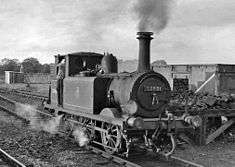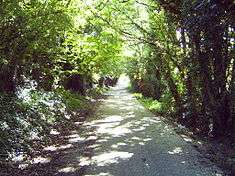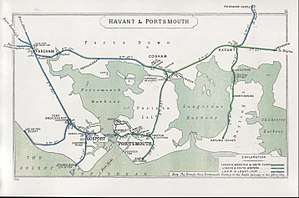Hayling Island branch line
The Hayling Island branch was a railway in Hampshire, England, that connected Havant with Hayling Island. It was sometimes known as the Hayling Billy, which is now the name of a footpath along the old track which is a Local Nature Reserve.[1]
| Hayling Island Branch Line | ||||||||||||||||||||||||||||||||||||||||||||||||||||||||||||||||||
|---|---|---|---|---|---|---|---|---|---|---|---|---|---|---|---|---|---|---|---|---|---|---|---|---|---|---|---|---|---|---|---|---|---|---|---|---|---|---|---|---|---|---|---|---|---|---|---|---|---|---|---|---|---|---|---|---|---|---|---|---|---|---|---|---|---|---|
| ||||||||||||||||||||||||||||||||||||||||||||||||||||||||||||||||||



History
The line was opened by the London, Brighton and South Coast Railway (LBSCR) for goods on 19 January 1865, and for passengers on 16 July 1867.[2] It ran from Havant to Hayling Island station. There were two intermediate stations at Langston (sic)[3] and North Hayling. Neither were ever "halts", in spite of their small size.[4]
The LBSCR quickly ran into difficulty during the construction of the railway, as they had attempted to save on the cost of buying land on Hayling Island for the line by constructing an embankment on the mud flats in the sheltered waters of Langstone Harbour. This was an ambitious plan, which also involved the construction of wet and dry docks at Sinah Lake. They were given a grant to the mudlands by William Padwick, who was himself behind the plan, and the promoters offered to build the embankment and Railway at a cost of £80,000,[5] but the area was not sheltered as had been hoped and the bank was severely eroded before the railway could be completed.
The Board of Trade inspector was invited to certify the line as being fit for passenger traffic, but he initially refused to do so as he found that many of the sleepers had begun to rot in the original section of the railway, and there was also an unauthorised level crossing at Langstone. The former problem was quickly fixed but the level crossing remained until the closure of the line.
The line itself was mainly used during the summer months as people from the South Coast travelled down to the beach on Hayling Island. The coaches were often overflowing during these months, but were almost empty during the winter.[6]
The line was taken over by the Southern Railway in 1923 and by British Railways in 1948. Because of the weight restriction on the bridge[7] it was worked, from late Victorian times to closure in 1963 by small LB&SCR A1/A1X Class locomotives.[8]
Closure
Over the winter of 1962 it was decided to close the branch[9] because the timber swing bridge which crossed Langstone Harbour needed to be replaced. The line was operating at a small profit but British Railways took the view that the cost of a new bridge was an unreasonably large investment. The final normal service train ran on the evening of 2 November 1963. Goods services continued until the final day but goods trains were not run separately. Instead goods were conveyed in mixed trains (passenger coaches, goods wagons and vans, and a brake van) and these were a feature of the branch until the end. To clear the remaining goods stock away, the final train from Hayling Island on Saturday 2 November 1963 was a mixed train hauled by A1X no. 32650. The day after closure a special was run, hauled by A1X nos. 32636 and 32670 and this was the last ever train on the branch. All three of these locomotives survive in preservation.
After closure and the line today
After closure, an attempt was made to re-open the line, using a former Blackpool Marton Vambac single deck tram, no. 11. The tram was stored in the goods yard at Havant, and later, on Hayling Island itself. With no support from the local authorities the venture came to nothing and the tram never ran on the line. Unlike the line, however, the tram survived, and is currently preserved in running order at the East Anglia Transport Museum. The attempted re-opening delayed the lifting of the track. This finally took place in the Spring of 1966, and included the demolition of most of the structure of the railway bridge at Langstone. A significant amount of the bridge remains, including the base of the swinging section, and what seem to be bridge piers. The bridge piers are, in fact, the lower parts of the wooden bridge structure which were enclosed in rectangular columns of concrete by the Southern Railway in the late 1920s, early 1930s. The columns stand on the bridge foundations, which were specially strengthened to deal with the tidal scour at this location.
Today, the area where the tracks once stood on the Havant side of the line is a Local Nature Reserve and footpath.[10][11] This enables people to walk from Havant station all the way to where the bridge and the level crossing was located, by Langston station, serving the village of Langstone.[12]
If one were to continue walking south from Langston station (the railway never spelled it with the final "e"), across the road bridge, they would join the Hayling Island side of the line. This section of the line passes down the west side of the island, passing through where North Hayling station used to stand, and terminates at West Town, the main area of population in the south of the island. Sadly, due to an arson attack, the old Crossing keepers' cottages near Langston railway station unexpectedly caught fire in December 2018 and were almost completely destroyed. The property company owning the site has been ordered to rebuild them. [13]

This section is now a combined footpath, bridleway and cycleway. It has recently become part of route 2 of the National Cycle Network, sponsored by Sustrans, a charity for sustainable transport.
Gallery
- Station Master's House at Langston(e).
.jpg) Site of the old station at North Hayling.
Site of the old station at North Hayling.- The line ran very close to the coast in places.
.jpg) The goods shed at Hayling Island Station is now a Theatre.
The goods shed at Hayling Island Station is now a Theatre.
References
- "The Hayling Billy Leisure Trail" Marshall, B Havant, Bosmere Hundred Society, 1992
- "Catching the train to Hayling Island: a history" Newell, L: Havant, Havant Borough Council, 2005 OCLC 867901079 (2003)
- Truncated by the Railway Timetablers, a common practice with place names ending with e
- Hampshire railways remembered Oppitz,L Newbury, Countryside 1988 ISBN 1-85306-020-8
- called South Hayling until 1892 "Branch Line to Hayling" Mitchell,V./Smith,K (In association with Bell,A): Midhurst, Middleton Press, 1984 ISBN 0-906520-12-6
- "Southern Holiday Lines in Hampshire and the Isle of Wight" Bennett,A Cheltenham, Runpast 1994 ISBN 1-870754-31-X
- "The Book of Hayling Island-more than a millennium"Rogers,P: Tiverton, Halsgrove, 2000 ISBN 1-84114-078-3
- Memories of the Hayling Island Branch:Produced by Ian Heys for "Branch Line Videos", Catalogue Number 418-514424
- Closure details
- "Hayling Billy". Local Nature Reserves. Natural England. Retrieved 4 August 2013.
- "Map of Hayling Billy". Local Nature Reserves. Natural England. Retrieved 4 August 2013.
- "A Guide to Hayling Island" Pierce Jones,V/Walton,R. :Hayling Island, waltondesign, 2005
- https://www.portsmouth.co.uk/news/campaigners-over-the-moon-as-council-orders-rebuild-of-fire-ravaged-langstone-railway-cottages-1-8762719